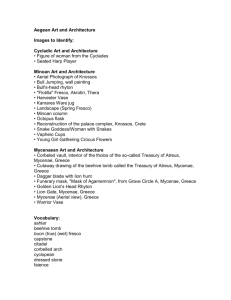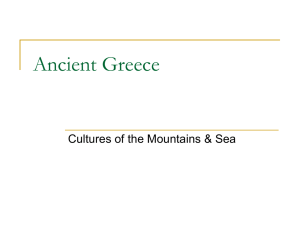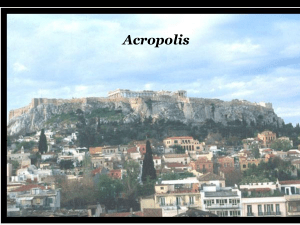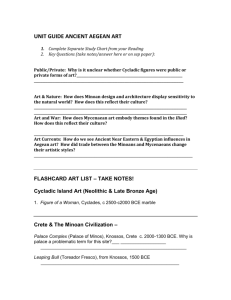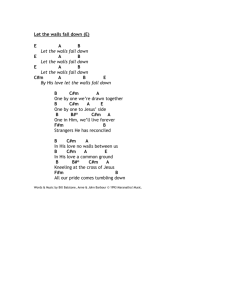Mycenae
advertisement
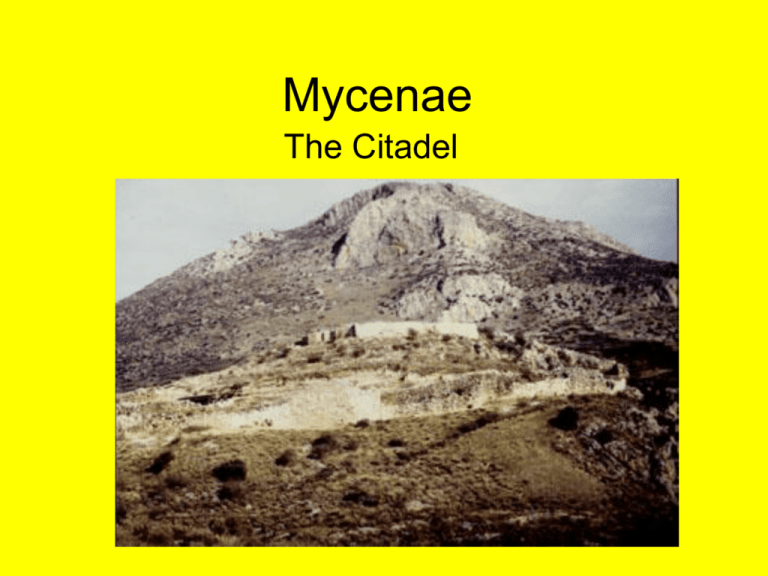
Mycenae The Citadel Mycenae • Enduring Understanding: Mycenaeans were an advanced Bronze Age civilization which existed in a time of much warfare. Mycenaeans took great measures to guard themselves from attack and were skilled craftsmen, architects and artists. Mycenae • Brief History: – Location: Mainland of Greece – Mycenae was one of a number of small kingdoms in mainland Greece during Bronze Age. – It was the most important, so the civilization encompassing all of the kingdoms is known as Mycenaean, after Mycenae. Mycenae • History: Archaeology – Heinrich Schliemann first to really do much work on the site, he was famous for having discovered Troy. • • • • He began excavating in late 1830’s. Lion’s Gate discovered in 1841. 1874, he discovered shaft graves. He also was the first to explore Tiryns in 1876. – Christos Tsountas excavated from 1880-1902. • He uncovered the palace and the secret cistern. – Excavations continued until the 1950’s. – Other archaeologists are: Dorpfeld, 1880’s, Blegen, 1950’s. Both excavated at Pylos, where the palace of Nestor was. Mycenae • Plan of Mycenae: Mycenae • The Defensive Walls: known as Cyclopean Walls by later Greeks. Because they believed the stones were so large that not even the Cyclops could move them. Mycenae • Cyclopean Walls: Very large stones were used. Mycenae • Walls: There are different kinds of walls at Mycenae: – Polygonal Walls: stones shaped to fit together. – Ashlar Walls: stones cut into finely cut blocks. Polygonal Walls Ashlar Walls Mycenae • The Lion Gate: The road to Mycenae led to the main gate, “The Lion’s Gate”. So named because of the lion reliefs at the top of the wall. lions Mycenae • Lion’s Gate: Mycenae • Walls: the walls were built from 15th BC to 13th BC. – Earliest wall: encompassed palace area. – Walls extended in 13th BC. to include Grave circle A. Mycenae • Walls: looking from Grave Circle A, one can see the walls along with foundations of buildings close by the circle. Mycenae • The road within the walls leads to the palace, which is at the summit. Lion’s Gate Road Mycenae • Palace of Agamemnon most of it has been lost. What can be seen here is remnants of the Megaron or large room (king’s meeting room). Notice circular hearth, remnants of columns. Mycenae • Hearth: This hearth, better preserved is from another Mycenaean site, Pylos. Mycenae • Water Stair: past the palace, far eastern end of the citadel, a water stair cut into the rock, built down to a spring fed source. It provided a secure source of water during a siege. Mycenae • Sally Port: An opening in the wall, allowed scouting parties to survey the area in the event of a siege. Mycenae • Postern Gate: Mycenae • Many houses were built within the citadel walls. Many were also built outside those same walls. • Also scattered throughout the area are Tholos tombs (shaped like beehives). Mycenae • Other pictures: Inside the walls. Mycenae • Other pictures: Mycenae • Other pictures: Mycenaeans • Essential Questions: • From what they produced, what do you believe the Mycenaeans were most concerned about? • Provide examples to show that the Mycenaeans were an advanced civilization. • How de we know the Mycenaeans were always prepared for attacks?

